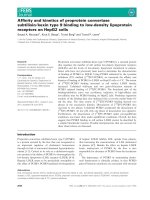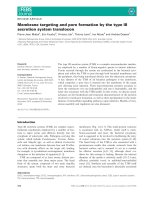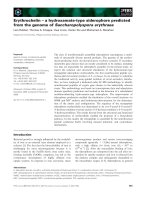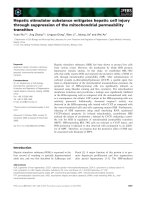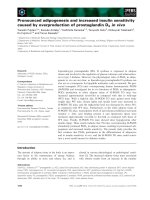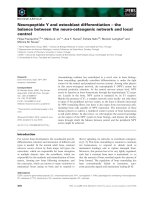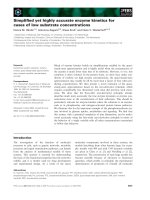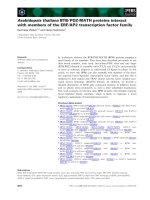Tài liệu Báo cáo khoa học: "NATURAL LANGUAGE AND COMPUTER INTEBFACE DESIGN MURRAY TUROFF DEPARTMENT OF COMPUTER AND IiVFORMATION SCIENCE IIEW JERSEY INSTITUTE OF TECHNOLOGY" ppt
Bạn đang xem bản rút gọn của tài liệu. Xem và tải ngay bản đầy đủ của tài liệu tại đây (223.26 KB, 2 trang )
NATURAL LANGUAGE AND COMPUTER INTEBFACE DESIGN
MURRAY TUROFF
DEPARTMENT OF COMPU%'z~ AND IiVFORMATION SCIENCE
IIEW JERSEY INSTITUTE OF TECHNOLOGY
SOME ICONOCLASTIC ASSERTIONS
Considering the problems we have in communicating with
other h~rmans using natural language, it is not clear
that we want to recreate these problems in dealing with
the computer. While there is some evidence that natur-
al language is useful in communications among humans,
there is also considerable evidence that it is neither
perfect nor ideal. Natural language is wordy (redun-
dant) and imprecise. Most b,*m,m groups who have a need
to communicate quickly and accurately tend to develop a
rather well specified subset of natural language that
is highly coded and precise in nature. Pilots and po-
lice are good examples of this. Even working groups
within a field or discipline tend over time to develop
a jargon that minimizes the effort of communication and
clarifies shared precise meanings.
It is not clear that there is any group of humans or
applications for computers that would be better served
in the long run by natural language interfaces. One
could provide such an interface for the purpose of ac-
climating a group or individual to a computer or in-
formation system environment but over the long run it
would be highly inefficient for a h,mAn to continue to
use such an interface and would in a real sense be a
disservice to the user. Those retrieval systems that
allow natural language like queries tend to also allow
the user to discover with practice the embedded inter-
face that allows very terse and concise requests to be
made of the system. Take the general example of COBOL,
which was designed as a language to input business
oriented programs into a computer that could be under-
stood by non-computer types. We find that if we don't
de,and that progrmmmers follow certain standards to
make this possible, they will make their programs
cryptic to the point where it is not understandable to
anyone but other progro,,mers.
It is interesting to observe that successful inter-
faces between persona and machines tend to be based
upon one or the other of the two extreme choices one
can make in designing a language. One is small, well
defined vocabularies from which one can build rather
long and complex expressions and the other is large
vocabularies with short expressions. In some sense,
"natural language" is the result of a compromise be-
tween these two opposing extremes. If we had same
better understanding of the cognitive dynamics that
shape and evolve natural language, perhaps the one
useful natural language interface that migjat be de-
veloped would allow individuals and groups to shape
their own personalized interface to a computer or in-
formation system. I em quite sure that given such a
powerful capability, what a group of users would end
up with would be very far from a natural language.
The argument is sometimes made that a natural language
interface might be useful for those who are linguisti-
cally disadvantaged. It might allow very young child-
ten or deaf persons to better utilize the computer. I
see it as immoral to provide a natural language intro-
duction to computers to people who might mistakenly
come to think of a computer as they would another hu-
man being. I would much prefer such individuals to be
introduced to the computer with an interface that will
give them some appreciation for the nature of the ma-
chine. For example, a very simple CAI language called
PILOT has been used to teach grammar school children
how to write simple lessons for their classmates. The
ability of the young children to write simple question
answer sequences and then see them executed as if the
computer was able to use natural language is, I be-
lieve, far more beneficial to the child than giving
him canned lessons as his or her first impression of
what a computer is like.
COMPUTERIZED CONFERENCING
Since 1973 at the New Jersey Institute of Technology,
we have been developing and evaluating the use of a
computer as a direct aid to facilitating human communi-
cation. The basic idea is to use the processing and
logical capabilities of the computer to aid in the
communication and exchange of written text (Hiltz &
Turoff, 1978). As part of this program we have been
operating the Electronic Information Exchange System
(EIES) as a source of field trial data and as a labora-
tory for controlled experimentation. Currently, EIES
has approximately 600 active users internationally.
Our current rate of operation is about 5,000 user hours
a month; 8,000 messages, conference c~-,-ents and note-
book pages written a month and about 35,000 delivered
each month. The average message is about l0 lines of
text and the average comment or page is about 20 lines
of text.
EIES offers the user a complete set of differing inter-
faces including menus, commands, self-defined commands
and self progra,,m4ng of interfaces for individuals and
groups. In addition to the standard message, confer-
ence and notebook features, EIES has been designed with
the incorporation of a computer language called "INTE~-
ACT" that allows special communication structtkres and
data structures to be integrated into the application
of any specific group. Much of this capability has
evolved since 1976 through a numerous set of alterna-
tive feedback and evaluation mechanisms. Our users
include scientists, engineers, managers, secretaries,
teenagers, students, Cerebral Palsy children and 80
year old senior citizens. In all this experience we
have yet to hear a direct request or even implicit
desire for any sor~ of natural language like interface.
To the contrary, we have indirect empirical data that
supports the premise that a natural language llke
interface would be a disadvantage. For the most
• part, the behavior of users on EIES is very sensitive
to the degree of experience they have had with the
system. However, there is one key parameter which is
insensitive to the degree, of experience or the rate
of use of the system. This is the number of items a
user receives when he or she sits down at the terminal
to use the system. This number stays at around 7 plus
or minus 2. This is obviously a prescriptive effect
the system has on the user as they get into the habit
of signing on often enough so that they will not have
more than around 7 new text items waiting for them.
Users who have been cut off for a long period by a
broken terminal or a vacation that denies them access
usually give ou~ textual screams of "information over-
load" when they find tons of tex~ items waiting for
them. In a
real
sense, it is natural language that is
generating this information overload for the user.
Another pertinent observation is that each user has
three unique identifiers; a full name, a short nicK-
name, and a three digit number. Some users always use
nicknames and some always use numbers to address their
messages but I have yet to encounter anyone who uses
full heroes on a regular basis.
AUTOMATED ABSTRACTING
Our observations do point to one application where the
ability to process natural language would be a signi-
ficemt augmentation of the users cf computerized ccn-
ferencing systems. We have a large number of confer-
ences that have been going on for over a year and which
conta/n thousands of comments. While a person entering
such an on-going discussion can, in principle, go back
and read the entire transcript or do selective retriev-
al on subtopics, it would be far preferable to be able
to generate autc~a~ic summaries of such large text
files. Even for regular use, the ability to zet auto-
mated su.~maries would significantly raise the threshold
of information overload and allow users to increase
their level of co unication activity and the amount of
information with which they can deal meaningfully.
The goal of being able to process natural language has
always been a bit of a siren's call and has a cerma.in
note of purity about it. Those striving for it some-
times lose sight of the fact thst an imperfect system
may still be quite useful when the perfect system may
be unobtainable for some time. One of the important
problems well recognized in the computer field is
teaching computers how to "forget" or eliminate gar-
bage. A less well recognized problem is the one of
teaching a computer how to "give up" gracefully and go
to a human to get help. In other words, the natural
language systems that may have significant payoff in
the next decade are those that blend the best talents
of man and m~chine into one working unit.
In the computerized conferencing environment, this means
that a person requesting a su~ of s long conference
probably knows enough about the substance to guide the
computer in the process and to tailor the summary to
particular needs and interests. In computerized con-
ferencing, the ultimate goal is "collective intelli-
gence" and one hopes that the apprcpriate design of a
communication structure will allow a group of humans to
pool their intelligence into something greater than any
of its par~s. If there is an automated or artificial
intelligence system, then providing that system as a
tool to a group of humans as an integral par~ of their
group communication structure, the resulting intelli-
gence of the group should be greater than the auto-
mated system alone. I believe ,a similar observation
holds for the processing of natural language. Too often
those working in natural language seem to feel that in-
tegrating humans into the analysis process would be an
impurity or contaminant. In fact, it may be the higher
goal than mere automation.
WRITING STYLE
A related area with respect to computerized confer-
encing is the observation that the style of writing in
this medium of co~mluicaticn differs from other uses
of the written or spoken version of natural language.
First of all, there is a strong tendency to be concise
and to outline complex discussions. We can observe
this directly in the field trials and also observe that
users bring group pressure upon those who star~ to
write verbose items or items off the subject of inter-
est to the group. The mechanism most commonly em-
ployed is
the
anonymous message. Also, in cur con-
trolled experiments on h, an problem solving (Hiltz,
et ai, 1980) we have found that there is no differ-
ence in the quality of a solution reached in a face-to-
face environment or in a computerized conferencing en-
vironment. However, we do observ~ that the computer-
ized conferencing groups use appro imately 60% fewer
words to do just as good a Job as the face-to-face
groups. Using Bales Interaction Process Analyses
(content analyses), we have also confirmed signifi-
cant differences in the content of the communica~ious.
New users go through a learning period in which it may
take l0 to 20 hours tc feel comfortable in writing in
conferences. We feel this is due to the subconscious
recognition that people wTite differently in t2~is
medium than in letters, memos or other forms of the
written
language.
The majority
of what
a new user
writes (95%) will be messsges the first five hours of
usage and it takes about i00 hours until 25% of their
writings are in conferences. Also, it is about i00
hours before they feel comfortable in wTiting larger
tex~ items in notebooks. One other aspect in the style
change is ~he incorporation cf many non-verbal ques
into written form (HA' HA', for example). One cannot
see the nod of the head or hear a gentle laugh.
Another aspect of natural language processing ~t
can
aid users in this form of ccamunications is help in
overcoming learnin~ curves of this sor~ by being able
to process the tex~ of a group and provide a ecmpara-
tire analysis to new members of a group so ~hey can
more quickly learn the style of the group and feel eel-
for%able in cm~mmnicating with the group. One can
carry this f~er and ask for abilities to deal in
certain levels cf emotion such as :
I would like to
make my statement sound more
anser%-lve.
CONCLUSION
I do believe that this form of human cn""u~icatlon will
become as widespread and as significant as the phone
has been to our society.
The ~t~e
application of
natural language processing
really
lies in this area;
however, it is not in the interface to the cure,purer
that this futttre rests but rather on the ability of
this field to provide h~-ns direct aids in processing
the tex~ found in their c~-w, unications. Perhaps the
real subject tc address is not the one with which this
panel was titled but the problems e{ person-machine
interface to natural language processing systems. Or,
better yet, person-machine integration within natural
language processing. The computer processing of natur-
al language needs to becume the tool of the wTiter,
editor, translator and reader. It also has to aid us
in improving our ability to co~unicate. Most organi-
zations are run on cammunications and the lore that is
contained in those c~ unications. With the increasing
use of camputers as communication devices, the qualita-
tive information upon which we depend becomes as avail-
able for processing as the quantitative has been.
Re ference :
THE NETWORK NATION: H, ~ C munication Via Computer,
Start Rcxanne Hiltz and Murray Turoff, Addison-Wesley
Advanced Book Program, 1978.
FACE TO FACE VS. COMPUTERIZED CON~It~NCING: A con-
trolled Experiment, Hiltz, Johnson, Aronovitch and
Turoff, Report of the C~uterized Confereneing and
Communications Center, NJ!T, January 1980.
